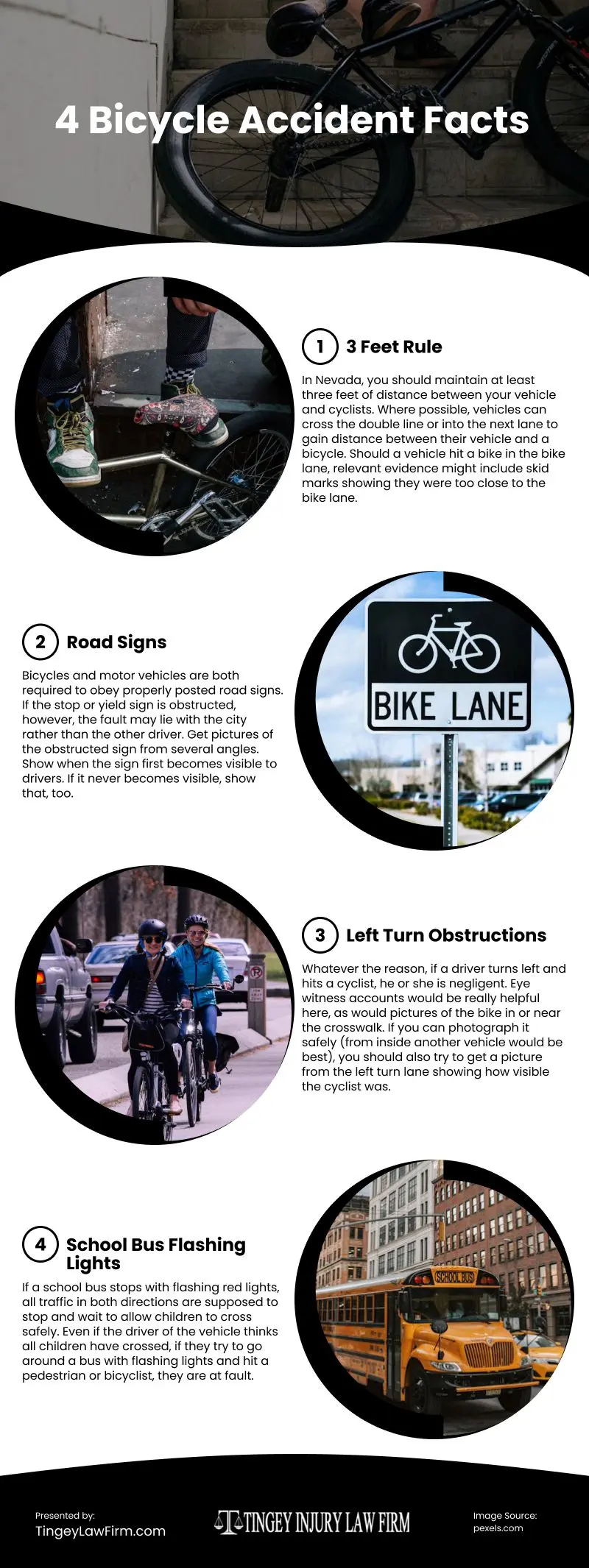
Riding a bicycle is a great choice for those who want to commute in a healthier, more eco-friendly, and economical way. However, cyclists are more vulnerable to accidents since they have no protection from larger vehicles. Therefore, it is crucial to collect evidence in case of an accident.
It’s important to have a clear understanding of Nevada’s bicycle laws so that you can gather the necessary evidence to prove if the other party was at fault. Here are some common scenarios and corresponding laws that can help you understand what type of evidence you’ll need for specific cases.
3 Feet Rule
In Nevada, drivers must maintain a minimum of three feet distance between their vehicles and bicycles. When possible, drivers can cross the double line or enter the next lane to create a safe distance between their vehicles and bicycles.
If a vehicle collides with a bike in the bike lane, important evidence to consider could be skid marks left on the road. Skid marks could indicate that the vehicle was driving too close to the bike lane, or that the driver attempted to go around the bike but failed to pay attention to oncoming traffic. This could have caused them to over-correct and swerve back into their own lane.
Left Turn Obstructions
When a vehicle is making a left turn, the frame around the windshield (known as the A-pillar) can obstruct the driver’s view of the crosswalk. This problem is especially common with larger SUVs and trucks. Even though pedestrians and cyclists have the right of way in the crosswalk, the driver may forget to check their blind spots. This can happen because they are distracted while timing their turn to avoid oncoming traffic, or because visibility is low due to weather conditions.
If a driver hits a cyclist while making a left turn, they are negligent. Eyewitness accounts and pictures of the bike in or near the crosswalk would be helpful. If safe, take pictures from inside another vehicle and the left turn lane to show how visible the cyclist was.
Road Signs
Both bicycles and motor vehicles are required to obey road signs that are properly posted. For instance, if a car fails to stop or yield at a sign, you should take pictures of the road signs and skid marks to demonstrate that they attempted to stop after crossing the line.
However, if the stop or yield sign is obstructed, it may be the city’s fault rather than the other driver’s. In such a case, you should take pictures of the obstructed sign from multiple angles. Also, show when the sign first becomes visible to drivers, and if it never becomes visible, then capture that as well.
School Bus Flashing Lights
If a school bus comes to a stop with flashing red lights, all traffic, in both directions, is required to stop and wait until the children have safely crossed the street. At that point, the location where the bus stops becomes a temporary crosswalk, regardless of its position on the street.
In a school zone, when a bus stops to let children on or off, it is possible that another child riding a bike may use the perceived safety provided by the bus to cross the road. Even if the driver of a vehicle thinks all children have finished crossing, they are still responsible for ensuring that there are no pedestrians or bicyclists in their path before attempting to pass the stopped bus. If they try to go around a bus with flashing lights and hit a pedestrian or bicyclist, they are at fault.
The right evidence is crucial to support your personal injury claim. In case you are unsure about the evidence required, it is recommended to consult a bike accident attorney in Las Vegas at the earliest.
source: https://tingeylawfirm.com/injured-while-biking-heres-the-evidence-youll-need-to-win-your-legal-case/
Comments
Download this infographic.
